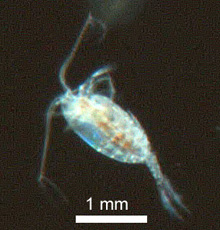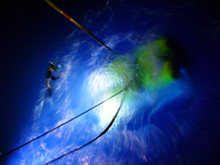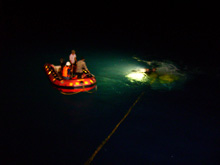Fig. 1. Nick Caloyianis photographs collected animals in the remotely operated vehicle (ROV) canisters underwater before it is lifted aboard. Image courtesy of 2007: Exploring the Inner Space of the Celebes Sea.
Rescue 911
October 10, 2007
Caron De Mars
Environment, Science, and Technology Officer
U.S. Embassy, Manila
![]() Scientists observe assorted sea cucumbers at 2,800 meter depth.
(Quicktime, 2.1 Mb.)
Scientists observe assorted sea cucumbers at 2,800 meter depth.
(Quicktime, 2.1 Mb.)
This morning, however, there was a snag in the recovery process. The pilot in the control room radioed his team on deck that one of the ROV’s thrusters (motors with propellers) had failed. Due to high water temps, a blown fuse caused the thruster to lose power. This was serious; once the ROV is back on the surface, it has to drive under its own power close to the side of the ship to be hoisted on board. It is hard to get a tow truck to come to the middle of the Celebes Sea at 3 am! Luckily, we had the Philippine Navy Seals and National Geographic TV cinematographer Nick Caloyianis on hand to come to the rescue. At times I feel like I’m in some made-for-TV movie on this ship; every 24 hours something seems to go terribly wrong, and heroes appear to resolve everything!
Nick is no stranger to adversity at sea. His formal education included post graduate work in marine biology; and in 1972, as a research assistant to Dr. Eugenie Clark, he participated in a study of sleeping sharks discovered in underwater caves at Isla Mujeres in the Caribbean waters off Mexico. Ironically, in 1992, he was in the same area, filming a feisty bull shark for National Geographic, when he saved his foot and hand (and probably his life) by shoving his camera into the angry shark's mouth. Twenty-one hospital days and many surgeries later, he regained use of his appendages. Although he carries impressive battle scars, he continues to log thousands of hours working underwater.
Fig. 2. The ROV rescue party watches from the rubber boat as Nick Caloyianis hooks the disabled ROV onto the winch wire so it can be hoisted onto the deck. Image courtesy of 2007: Exploring the Inner Space of the Celebes Sea.
Nick and the Navy Seals plopped into the rubber boat, which had been lowered into the ocean for its special rescue mission. The weak outboard motor wasn’t much of a match for the hefty ROV, so Nick and the Seals had to compensate for its deficiencies with brute strength. Nick wrestled the ROV as effectively as he wrestled that shark, snapped on the winch hook, and jumped in beside the ROV with his camera to film the catches of the day in their canisters before the machine was lifted out of the water.
The more spectacular specimens got a place of honor in the kreisel, the whirling vertical round tank. As the jellyfish, sea cucumbers, worms, spider-like isopods, and other marine creatures somersaulted around the tank, the scientists, photographers, and cinematographers recorded their behavior. This morning’s main attraction was a translucent red sea cucumber with a winding brown digestive track. The smaller “summer stock” tank displayed two blueberry-sized creatures, transparent radiolarians that looked like see-through land mines.
I inched my way out of the over-subscribed lab and went to bed at about 4 am. A couple of hours later, I sat at the breakfast table with Dr. Larry Madin, who had pulled an all-nighter with some of his favorite gelatinous life forms. He was going to pickle yet another creature before getting much-needed rest. Larry’s stamina is impressive. Even with sleep deprivation, he is good-natured, has a wicked sense of humor, and is always a kind gentleman. It is no wonder that he is the chief scientist on this expedition and holds an important position at the Woods Hole Oceanographic Institution, the world’s largest private oceanographic institution.
I’m back in the lab now, meticulously logging the time when the ROV was placed back into the action after its thruster was repaired this morning, along with our coordinates and other data essential to detailing this mission. As I write, I wonder what the next 911 emergency will be, and which hero will emerge.





























